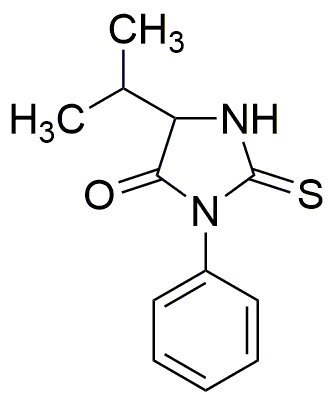Phenylthiohydantoin-valine is widely utilized in research focused on:
- Protein Sequencing: This compound is used in the Edman degradation method, which allows researchers to determine the amino acid sequence of proteins. Its ability to selectively react with the amino terminal of peptides makes it invaluable in biochemistry.
- Peptide Synthesis: It serves as a key reagent in synthesizing peptides, particularly those containing valine. This application is crucial in drug development and the creation of therapeutic proteins.
- Analytical Chemistry: The compound is employed in various analytical techniques to identify and quantify amino acids in complex mixtures, aiding in quality control in food and pharmaceutical industries.
- Biotechnology: In genetic engineering, it is used to analyze and modify proteins, enhancing the development of genetically modified organisms (GMOs) for agricultural applications.
- Pharmaceutical Research: Its role in drug formulation and testing helps in the development of new medications, particularly those targeting specific protein interactions, improving therapeutic efficacy.
Informations générales
Propriétés
Sécurité et réglementation
Applications
Phenylthiohydantoin-valine is widely utilized in research focused on:
- Protein Sequencing: This compound is used in the Edman degradation method, which allows researchers to determine the amino acid sequence of proteins. Its ability to selectively react with the amino terminal of peptides makes it invaluable in biochemistry.
- Peptide Synthesis: It serves as a key reagent in synthesizing peptides, particularly those containing valine. This application is crucial in drug development and the creation of therapeutic proteins.
- Analytical Chemistry: The compound is employed in various analytical techniques to identify and quantify amino acids in complex mixtures, aiding in quality control in food and pharmaceutical industries.
- Biotechnology: In genetic engineering, it is used to analyze and modify proteins, enhancing the development of genetically modified organisms (GMOs) for agricultural applications.
- Pharmaceutical Research: Its role in drug formulation and testing helps in the development of new medications, particularly those targeting specific protein interactions, improving therapeutic efficacy.
Documents
Fiches de données de sécurité (FDS)
La FDS fournit des informations de sécurité complètes sur la manipulation, le stockage et l’élimination du produit.
Spécifications du produit (PS)
Le PS fournit une description complète des propriétés du produit, notamment sa composition chimique, son état physique, sa pureté et les exigences de stockage. Il détaille également les plages de qualité acceptables et les applications prévues du produit.
Certificats d'analyse (COA)
Recherchez des certificats d'analyse (COA) en saisissant le numéro de lot du produit. Les numéros de lot et de lot se trouvent sur l'étiquette d'un produit, après les mots « Lot » ou « Lot de fabrication ».
Numéro de catalogue
Numéro de lot/série
Certificats d'origine (COO)
Ce certificat d'exploitation confirme le pays dans lequel le produit a été fabriqué, et détaille également les matériaux et composants utilisés et s'il est issu de sources naturelles, synthétiques ou autres sources spécifiques. Ce certificat peut être requis pour les douanes, le commerce et la conformité réglementaire.
Numéro de catalogue
Numéro de lot/série
Fiches de données de sécurité (FDS)
La FDS fournit des informations de sécurité complètes sur la manipulation, le stockage et l’élimination du produit.
DownloadSpécifications du produit (PS)
Le PS fournit une description complète des propriétés du produit, notamment sa composition chimique, son état physique, sa pureté et les exigences de stockage. Il détaille également les plages de qualité acceptables et les applications prévues du produit.
DownloadCertificats d'analyse (COA)
Recherchez des certificats d'analyse (COA) en saisissant le numéro de lot du produit. Les numéros de lot et de lot se trouvent sur l'étiquette d'un produit, après les mots « Lot » ou « Lot de fabrication ».
Numéro de catalogue
Numéro de lot/série
Certificats d'origine (COO)
Ce certificat d'exploitation confirme le pays dans lequel le produit a été fabriqué, et détaille également les matériaux et composants utilisés et s'il est issu de sources naturelles, synthétiques ou autres sources spécifiques. Ce certificat peut être requis pour les douanes, le commerce et la conformité réglementaire.


